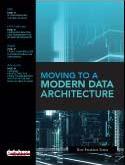
Underpinning the movement to compete on analytics, a major shift is taking place on the architectural level where data is captured, stored and processed. This transformation is being driven by the need for more agile data management processes in the face of increasing volumes and varieties of data, and the growing challenge of delivering data where and when it is needed. Right now, data architecture is more important than ever, and one thing is clear: the old models aren’t enough for today’s data-driven business demands.
As a result, a growing number of organizations are modifying their data architectures to include new technologies, from Hadoop and Spark, to NoSQL databases, in-memory platforms, and a flourishing market of cloud-based solutions. These technologies add new and distinct capabilities to the practice of data management – each fit for different data workloads and use-cases. In order to avoid data silos, they need to be integrated under a common architecture, and that architecture needs to be designed for change while maintaining enterprise-grade governance and security. Download this special report today to understand the key technologies and best practices.